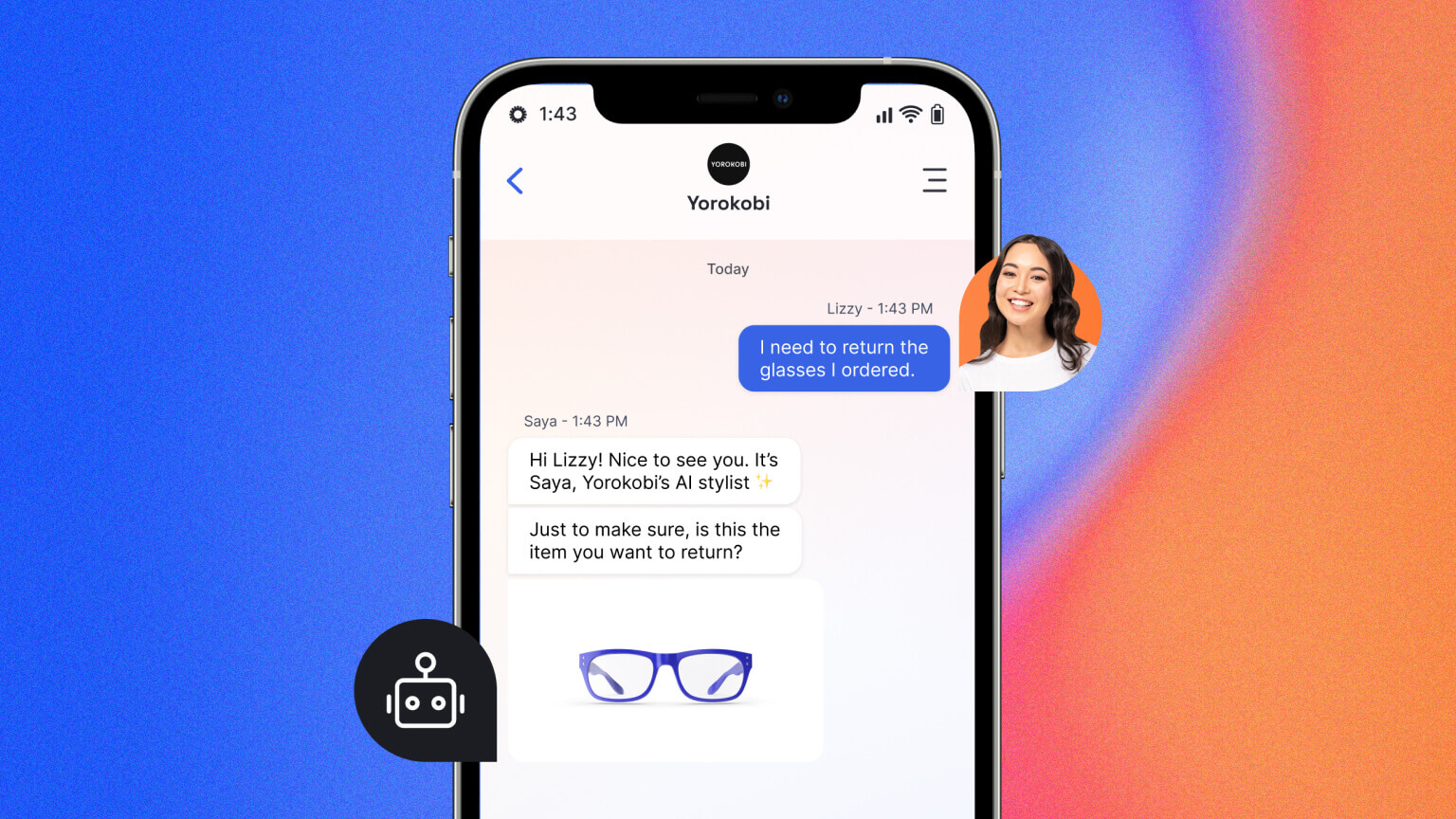article
Our journey to building a more Curiously Human™ AI
We are innovating Conversational AI to fix the broken customer experience
February 15, 2022 • 9 minutes

Have you ever had an experience like the one below?
In this conversation, everyone loses. A customer, ready to buy shoes and looking to do it conversationally, keeps reaching the same dead-end. The company, “bestshoesever.com,” loses a sale, and probably a customer, too. To make matters worse, the company won’t even understand that this conversation is broken. On the back end, when this customer abandons the chat, the conversation will be counted as “contained,” and if a CSAT survey comes, this customer almost certainly won’t bother to fill it out. In fact, to bestshoesever.com, this conversation will likely be counted as a success. #Yikes

The first step to improving is knowing you have a problem: This is a broken customer experience, not a successful one.
We’re excited to share our journey toward helping brands create more successful, more Curiously Human™ digital experiences by announcing the general availability of several new product enhancements to Conversational Cloud®, our Conversational AI platform. Our goal is to help brands create great conversations, and to do that, we’ve taken our cues from the ways humans are great conversationally. More on that below, but first, let’s talk about why this is so important.
Consumers are asking for Curiously Human experiences
At the macro level, the stakes for Conversational Commerce are high, just as they were for e-commerce 25 years ago. Brands that win will use great conversational engagements to make billions, and brands that lose will suffer, or even go bust. Unlike 25 years ago though, today’s consumers are rapidly shifting their mindset — they are ready for, and even demand, this new type of interaction with brands. In our 2021 Consumer Preferences Report, we found:
- 83% of customers say they will browse and buy from brands directly in messaging channels.
- Over 3 quarters (78%) of consumers want the ability to securely message any business.
Connecting with consumers through their preferred messaging channels is also very good for brands:
- 63% of customers say messaging with a company makes them feel a more personal connection.
- 79% of customers are more likely to make a purchase with a brand they feel a personal connection to.
- 86% of customers are more likely to do business with a brand that interacts with them in a positive way.
Perhaps most importantly, consumers are suddenly, radically more open to automated conversations now than ever before:

Ultimately, winning at Conversational Commerce means building a great customer experience using Conversational AI. But how do you do that? The late 2010s are littered with startups that claimed they had miracle answers to this question. At LivePerson, we’ve steadily grown our automation footprint to billions of interactions, and along the way, we learned to let the concept of “Curiously Human” guide us (and our brands).
What it really means to be Curiously Human
Curiously Human may not be what you think when you first hear it. When people talk about personalization and conversational commerce these days, a lot of airtime gets devoted to a cross between “fun and friendly” tones and old-school recommender systems. At LivePerson, we think that’s missing the point. Do you really want a chatbot whose best move is this?

The overdone, superficial tone and the out-of-the-blue recommendation make this feel like a marketing device, not like a real conversation, and the conversation fails to deliver any real help. A human would know you buy wax because you already have a surfboard, and would pick up the cue on a new bag, seeing this as the real opportunity to help this customer. We don’t need cute tricks, we need a system that’s focused on us, and can adapt. We need AI that’s exceptional at understanding us, connecting us to one another, and delivering better outcomes for both the brand and customer sides of the conversation. That’s Curiously Human.
What do humans do well in conversation? What really makes us feel good and understood?
More listening, flexibility, helpfulness, and less bias.
Here are a few things humans do really well that machines need to do too:
01: Humans listen
Humans don’t show up with a script and railroad you through it (at least not the good ones). Humans listen, understand, and adapt. In Conversational AI terms, this means to provide a great experience, you have to obsess over Natural Language Understanding (NLU). NLU is the part of the system that turns language into meaningful structured information for the dialogue, like, user intent or product reference. A robust and accurate NLU is absolutely necessary for agents and chatbots to provide rich and flexible experiences.
At LivePerson, we continually test and analyze conversations globally, and we consistently find that more than half of the errors chatbots have (even more on some platforms) are derived from NLU, creating moments where the bot simply doesn’t understand. To resolve this, brands should either build an in-house data science team that can create the required intent categories and processes, or they need advanced intent analytics and management systems for non-scientists. We realize not all brands can do the former, so we created Intent Analyzer and Manager to help make this work accessible to a business user, and AI Annotator to allow brands to use their best conversationalists to help train their NLU. We also created Conversation Assist to help agents easily drag and drop relevant responses.

02: Humans identify problems and miscues
Humans are amazing at spotting misunderstandings and other trouble spots in conversations, and finding ways to correct the situation. In fact, this is more prevalent in conversations than you might realize. The next time you’re in a meeting, particularly about something complex, try to notice how often people use phrases like “just to clarify,” “to confirm,” or “I think you said.” Through our analysis over the years, we’ve come to see that when people try to solve problems with brands, often the majority of the discussion is framing, organizing and confirming a shared basis of facts, noting and correcting confusion along the way. A Conversational AI platform needs to do the same, and this is different from NLU. NLU tends to be bad at knowing when it’s wrong, and terrible at knowing why it’s wrong.
This is why we built our proprietary Meaningful Automated Conversation Score (MACS). MACS is its own machine-learned model, providing an independent assessment of the health of the human-bot conversation, and includes a model trained to identify common problems (“going around in circles,” “misunderstands,” etc). MACS is a key step in creating self-learning and self-healing AI capabilities.

03: Humans read your cues and adapt to them
Humans are experts at knowing when a person is feeling open and talkative, when their interest is piqued by a specific subject, or when they might need a little space. We’re exceptional at this with people we know well, but we also are remarkably good at quickly reading people we don’t know and adapting. If Conversational AI can’t adapt the way a human can, it will ring false and it will annoy the user.
This is why we have real-time sentiment understanding built into our Conversational Cloud platform, and allow you to combine it with Dynamic Actions (launching soon). This allows brands to create conversational interrupts and adapt to the user’s preferences and emotions, in real time. Critically, this adaptation can be driven by outcomes, like conversational satisfaction/resolution, or even downstream purchase. This means the system can learn on its own, from thousands or millions of conversations, how to best help both consumers and brands.

04: Humans solve problems
Most of the time, we don’t reach out to a brand just for fun. We want someone to help us solve a problem in the real world — we want the conversation to be useful. Conversational AI must meet this fundamental need, or it will forever feel like a gimmick, and in the way.
That’s why we’re introducing our Integration Hub that links our AI to the apps and services you use every day. These integrations can help your customers resolve more tasks within one single conversation, from setting up appointments to signing documents, to making secure payments online. This is good news not only for the customer but for brands, too. Now, you can easily find, activate, and run thousands of integrations in one place through our self-service, no-code interface, rather than spend time and effort on complex extensibility projects.

All of these concepts are important for building great Conversational AI, but there’s one bigger, guiding principle we have that ties the Conversational Cloud together. One of our favorite sayings is, “Great AI isn’t built just in the lab.” It’s also built by the people and systems that it’s meant to emulate. That’s where the knowledge and data come from. For customer care, that’s the contact center, and for sales, that’s the sales floor. Your AI should be constantly infused with the knowledge of your people and systems, and your people should be able to get in the loop to help your system learn and adapt. Our tools and technology are built to help you bridge the gap between your business and your AI.
Start building Conversational AI with LivePerson, and join the billions of interactions happening on the platform today. You may just find your conversations becoming more and more Curiously Human.

